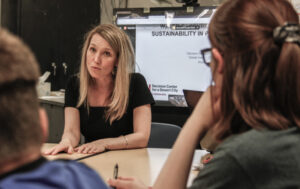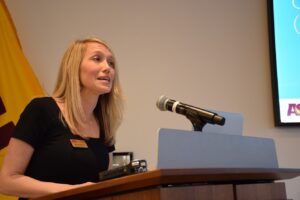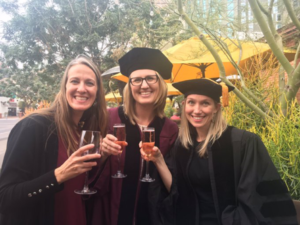Teaching
When I tell strangers I am an anthropology professor, they often tell me, “I loved the anthropology class I took in college!” Such comments convey the joys of teaching anthropology. Foreign images, fascinating customs, and far-away places easily capture students’ imaginations and engage their interest. Yet it is precisely this foreignness that can make it difficult to impact students’ lives in a lasting way. Inevitably, after saying they loved anthropology, people tell me, “But I did not major in it—what would you do with that in the real world?” Students often cannot see how anthropology provides tools to understand—and, perhaps more importantly, to build careers in—contemporary America. Engaging with these challenges is at the core of my teaching philosophy.

My first goal as a professor is to ignite students’ passion for anthropology and global health. My research examines human survival in the face of poverty, water scarcity, and food insecurity, and I use this as the basis for my teaching. In my course on “Poverty, Social Justice, and Global Health,” for example, I take the class on an intellectual journey through Chicago’s South Side, Brazil’s favelas, and Haitian health clinics to show how poverty creates premature death, lifelong disability, and grinding misery. Once I capture students’ attention with stories and images, I use demanding readings, intensive writing, and structured debates to help students critically evaluate and challenge received wisdom about poverty eradication. By the end of the course, students are armed with a deep understanding of how poverty creates health inequities, how their personal histories shape their own ethics, and how they can make productive contributions as professionals.

Beyond inspiring students, I have two main instructional goals. First, I strive to help students bring their passion and energy to bear on real-world problems in poverty, global health, and sustainability. Second, I aim to provide rigorous training in practical research skills. My instructional approach was honed as a faculty instructor in the National Science Foundation’s prestigious methodological institutes in cultural anthropology (2006-2016). In the NSF institutes—and my workshops at ASU’s Institute for Social Science Research—I employ a “teach the teachers” model designed to grow capacity for university-level instruction in social science methods. My experiences with the NSF methodological institutes have also shaped my teaching program at ASU in profound ways.

At ASU, I provide leadership in curriculum development by designing, in collaboration with ASU faculty and community partners, innovative research-oriented programs for undergraduate and graduate instruction. These programs demonstrate anthropology’s real-world relevance and develop students’ professional skills. I use four models to enhance education in the classroom and beyond. Here are examples of collaborative studies I developed using each model:
Lab-based Learning
I co-direct the Culture, Health, and Environment Lab (2010-present), where faculty and students work on NSF-funded research and develop cutting-edge skills for data collection and analysis. In the lab, I have mentored over 80 undergraduates and 25 graduate students.
Collaborative International Research
I designed the Global Ethnohydrology Study (2007-present), a multi-year, cross-cultural study that examines local ecological knowledge of water in 10 countries. Each year, this study provides hands- on research experiences through faculty-guided study abroad, research assistantships, and independent research. Through this study, I have provided mentorship opportunities for over 1000 undergraduates and 20 graduate students.
Locally-embedded Community-based Research
In South Phoenix Collaborative (2008-2013), my colleagues and I designed a participatory community-based study of health risks in a Latino immigrant community. This project trains historically-underserved Latino students in community-based research and outreach. On this project, I have collaboratively mentored 26 undergraduates and 13 graduate students.
Locally-engaged Citizen Science & Education
I designed the Science of Water Art (2010-2013), a citizen science study that partners students with 78 Arizona elementary and middle schools, the Maricopa County Board of Education, and SRP. This project teaches undergraduates about community partnerships, citizen science, and curriculum design. On this project, I collaboratively mentored 56 undergraduates and one graduate student.
In addition to developing research-oriented educational opportunities, I am passionate about innovating alternatives to traditional classroom teaching. To address the poverty and inequity I study as a researcher, I am particularly enthusiastic about alternative instructional formats that provide underrepresented groups with greater access to university-level education. My drive to make high- quality university education widely accessible motivates me to experiment extensively with non- traditional forms of teaching and share “lessons-learned” with my colleagues. Three examples:
Online teaching
As an “early adopter” of ASU’s online program, I was excited by the flexibility online formats afford students—especially those working multiple jobs to make ends meet. I was delighted to discover that innovative online tools can create a highly interactive, immersive learning experience.
Eight-week semester
With student debt increasing, 8-week courses can lower the cost of undergraduate degrees by speeding degree completion. I have begun offering 8-week courses, and see this innovation as one that helps increase the financial accessibility of a university education.
Hybrid teaching
I am inspired by recent research showing “flipped” classrooms (lectures online, classroom interaction) have better educational outcomes. Like online teaching and 8-week semesters, hybrid formats can help make coursework timing more flexible and speed students’ degree progression.
As a professor, my focus is on inspiring students, teaching them professional skills, and demonstrating how these skills can help them combat poverty and inequity. To expand my impact as a professor, I am dedicated to developing new approaches—whether through research mentorship or alternative teaching formats—to reach and motivate anthropology and global health students.
Through my national teaching program, ASU workshops, and informal relationships with colleagues, I have worked hard to provide innovative leadership in university-level teaching. In doing so, I hope to address the inequities I study—in small but significant ways—by increasing university access for underserved students and improving global health practices in disadvantaged communities.
Student and Mentoring List
Postdoctoral Scholars
Dr. Laura Castro-Diaz, 2022-current
Postdoctoral Position: NSF GCR/AWII/NEWN, Global Institute of Sustainability & Innovations
Dr. Mathews Wakhungu, 2023
Postdoctoral Position: AWII/NEWN, Global Institute of Sustainability & Innovations
Employment: Senior Research Scientist, National Museums of Kenya
Dr. Jelena Jankovic-Rankovic, 2022-2023
Postdoctoral Position: NSF GCR/NEWN, Global Institute of Sustainability & Innovations
Employment: Assistant Professor, Dept. of Anthropology, University of South Carolina
Dr. Anaís Delilah Roque, 2021-2022
Postdoctoral Position: NSF GCR Postdoctoral Research Scholar, ASU Future H2O
Employment: Assistant Professor, Department of Anthropology, Ohio State University
Dr. Barbara Quimby, 2020-2022
Postdoctoral Position: USDA Stakeholder Study, ASU Kyl Center for Water Policy
Employment: Assistant Professor, College of Natural & Comp. Sciences, Hawai'i Pacific Univ.
Dr. Julia (Chrissie) Bausch, 2018-2019
Postdoctoral Position: USDA Stakeholder Study, ASU Kyl Center for Water Policy
Employment: Policy Analyst, Environment and Climate Change Canada (Government of Canada)
Dr. Melissa Beresford, 2018-2019
Postdoctoral Position: Global Ethnohydrology Study, ASU Center for Global Health
Employment: Assistant Professor, Department of Anthropology, San José State University
Dr. Meskerem Glegziabher, 2016-2018
Postdoctoral Position: Outreach & Community Engagement, ASU Center for Global Health
Employment: Assistant Research Professor, SHESC, Arizona State University
Dr. Roseanne Schuster, 2016-2017
Postdoctoral Position: Global Ethnohydrology Study, ASU Center for Global Health
Employment: Assistant Research Scientist, SHESC, Arizona State University
Ph.D. Students
Graduated- Committee Member
Anaís Delilah Roque, Ph.D. in Environmental Social Science, Role: Chair, Graduation: 2021
Employment: Arizona State University, NSF GCR/GFL Postdoctoral Research Schola
Dissertation fund/site: ASU Provost & CLAS Multiyear Package Award, 2018-2021; Puerto Rico
Danelle Cooper, Ph.D. in Global Health, Co-chair, Graduation: 2021
Employment: Arizona State University, Counseling Services
Dissertation funding/site: American Indian College Fund; Native Hawaiian people
Christine DeMyers, Ph.D. in Anthropology, Role: Chair, Graduation: 2019
Employment: Pacific Institute, Research Associate on Climate, Water & Environmental Justice
Dissertation + Ph.D. funding/site: NSF GRFP #1462086, 2016-2019; U.S. Southwest
Melissa Beresford, Ph.D. in Anthropology, Role: Chair, Graduation: 2018
Employment: San José State University, Assistant Professor in Department of Anthropology
Dissertation funding/site: SSRC, NSF Cultural Anthropology DDIG #1459004; South Africa
Ashley Hagaman, Ph.D. in Global Health, Role: Chair, Graduation: 2017
Employment: Yale University, Assistant Professor in School of Public Health
Dissertation funding/site: Fulbright - Nepal, NSF Cultural Anthropology DDIG #1459811
Meg du Bray, Ph.D. in Anthropology, Role: Co-chair, Graduation: 2017
Employment: University of North Colorado, Assistant Professor in Environmental Studies
Dissertation funding/sites: NSF #0951366; Cross-cultural research
Rhian Stotts, Ph.D. in Anthropology, Role: Chair. Graduation: 2016
Employment: Arizona State University, Full-time Instructor in SHESC
Dissertation funding/sites: NSF #0951366; Cross-cultural research
Current committees – Chair role
Mohammad Jobayer Hossain, Ph.D. in Environmental Social Sciences, Role: Chair. Stage: PHD
Dissertation funding: SHESC Multiyear Funding Package Award, 2021-2025
Dylan Diaz-Infante, Ph.D. in Anthropology, Role: Chair. Stage: MA
Dissertation funding: Arizona Water Innovation Initiative, 2023-2027
Graduated – Committee Member
Abigail Colburn, Ph.D. in Nutritional Sciences, Committee Member, Graduation: 2022
Employment: Yale School of Medicine, Postdoctoral Researcher
Brenda Mora-Castillo, School of Transborder Studies, Committee Member, Graduation: 2022
Employment: Bellomy Market Research, Research Panel Moderator
Charlayne Mitchell, Ph.D. in Global Health, Committee Member, Graduation: 2021
Employment: Northwestern University, Assistant Professor of Instruction, Global Health
Mahir Yazar, Ph.D. in Environmental Social Science, Committee Member, Graduation: 2021
Employment: University of Bergen (Norway), Post-doctoral Scholar
Julianna Gwiszcz, Ph.D. in Anthropology, Committee Member, Graduation: 2018
Employment: Arizona State University, School of Sustainability, GFL Researcher
Ayesha Masood, Ph.D. in Anthropology, Committee Member, Graduation: 2017
Employment: Information Technology University, Pakistan, Assistant Professor
Sarah McCool, Ph.D. in Global Health, Committee Member, Graduation: 2017
Employment: Georgia State University, Clinical Associate Professor, School of Public Health
Heather Story Steiness, Ph.D. in Global Health, Committee Member, Graduation: 2016
Employment: University of Phoenix, Associate Dean, College of Health Professions
Alissa Ruth, Ph.D. in Anthropology, Committee Member, Graduation: 2014
Employment: Arizona State University, SHESC Director of Strategic Initiatives
Jacelyn Rice-Boayue, Ph.D. in Sustainable Engineering, Committee Member, Graduation: 2014
Employment: University of North Carolina–Charlotte, Assistant Professor of Engineering
Isa Rodríguez-Soto, Ph.D. in Global Health, Committee Member, Graduation: 2013
Employment: University of Akron, Assistant Professor of Anthropology
Meredith Gartin, Ph.D. in Global Health, Committee Member, Graduation: 2012
Employment: University of Alabama–Birmingham, Assistant Professor of Global Health
Current committees – Member role
Richard Southee, Global Health, Committee Member, Proposal Defended: Nov. 2022
Ph.D. funding: Interdisciplinary Enrichment Fellowship (IEF), ASU Graduate College
Krista Lawless, Environmental Social Science, Committee Member, Proposal Defended: Apr. 2023
Ph.D. funding: Interdisciplinary Enrichment Fellowship (IEF), ASU Graduate College
Liam Gleason, Anthropology, Committee Member, Proposal Defended: 2023
Ph.D. funding: GI Bill
Rachelle Edwards, Anthropology, Committee Member, Proposal Defended: 2023
Ph.D. funding: GI Bill
M.A./M.S. Students
Nargish Patwoary, M.S. in Biology, 2021, Committee Chair
Employment: Phoenix Allies for Community Health
Alicia Dinsmore, M.A. in Global Health, 2017, Committee Chair
Employment: Program Coordinator, Family & Community Medicine, University of Arizona
Drew Blasco, M.A. in Global Health, 2016, Committee Chair
Current enrollment: Postdoctoral Research Fellow, University of Michigan (Ph.D., NYU)
Colin Kunzweiler, M.A. in Sustainability, 2013, Committee Member
Employment: Associate at Analysis Group (2018 Ph.D. in Public Health, UI-Chicago)
Ashlan Falletta-Cowden , M.A. in Anthropology, 2011, Committee Member
Employment: Principal and Consultant at Holland Consulting
Sveinn Sigurdsson, M.A. in Anthropology, 2011, Committee Co-chair
Employment: Director, Organizational Performance Optimization at Petaluma Health Center
Tabitha Morris, M.A. in Global Health, 2011 Committee Chair
Employment: Healthcare Informatics Analyst at Blue Cross Blue Shield of Arizona
Melissa Kuhn, M.A. in Global Health, 2011, Committee Chair
Employment: Infectious Disease Data Specialist, Maricopa County
Zeenat Hasan, M.A. in Anthropology, 2009, Committee Member
Employment: Health Program Director, Asian Pacific Community in Action
Undergraduate Students
Madeleine Zheng, 2023, Honors Committee Chair
Post-graduation: Business Operations, Lightsource
Andrea Castro, 2023, Honors Committee Member
Post-graduation: MS student, School of the Sustainability, ASU
Claire Nichols, 2021, Honors Committee Chair
Post-graduation: MS student, School of the Environment, Yale University
Navneet Kumar, 2020, Honors Committee Chair
Post-graduation: MS student (Stem Cell Biology & Regenerative Medicine), USC
Daniela Ledesma, 2020, Honors Committee Co-Chair
Post-graduation: MPH student (Epidemiology), Johns Hopkins University
Jennifer Blech, 2019, Honors Committee Second Reader
Post-graduation: MA, Global Management (Non-profit leadership, GH track), ASU Thunderbird
Paula Kibuka Musoke, 2019, Honors Committee Chair
Post-graduation: MPH student at Columbia University
Andrea Ramirez, 2019, Honors Committee Chair
Post-graduation: MA, Anthropology, Universidad Nacional Autónoma de México
Monet Nazilla Niesluchowski, 2018, Honors Committee Chair
Post-graduation: Fulbright Scholar, Mongolia; MA in Public Diplomacy, Indiana University
Brittany Hale, 2018, Honors Committee Second Reader
Post-graduation: City Year Corps Member; MPH student at Columbia University
Chloe Warpinski, 2017, Honors Committee Chair
Post-graduation: Fulbright Scholar, Slovakia; MD-PhD student at the University of Florida
Ainsley Pfeiffer, 2017, Honors Committee Chair
Post-graduation: Fulbright Scholar, India
Austin Smith, 2017, Honors Committee Chair
Post-graduation: M.A. in Health Sciences student at Arizona State University
Emma (Dooley) Hawkins, 2016, Honors Committee Chair
Post-graduation: Medical Assistant, Barrow Brain & Spine; PA student, Midwestern University
Hannah McAtee, 2015, Honors Committee Chair
Post-graduation: Medical (M.D.) student at University of Iowa
Sarah Patel, 2015, Honors Committee Chair
Post-graduation: Medical (M.D.) student at University of Arizona - Phoenix
Drew Blasco, 2014, Honors Committee Chair
Post-graduation: M.A. in Global Health student at Arizona State University
Alyssa McAlister, 2014, Honors Committee Chair
Post-graduation: Employed as Informatics Analyst at Health Services Advisory Group
Laurel Grey, 2013, Honors Committee Chair
Post-graduation: Medical (M.D.) student at University of Arizona
Holly Vins, 2013, Honors Committee Chair
Post-graduation: Earned MPH at Emory Univ., Employed at US Centers for Disease Control
Alicia Dinsmore, 2012, Honors Committee Chair
Post-graduation: M.A. in Global Health student at Arizona State University
Arlis Jenkins, 2012, Honors Committee Second Reader
Post-graduation: FOCUS Program Coordinator, Maricopa Integrated Health Systems
Joseph Canarie, 2011, Honors Committee Chair
Post-graduation: Medical (M.D.) student at Dartmouth University
Elizabeth Unbehaun, 2011, Honors Committee Third Reader
Post-graduation: Account Manager at Yelp.com
Colleen Healy, 2010, Honors Committee Chair
Post-graduation: J.D., Duke University, Employed at Univ. of Michigan School of Public Health
Allen Shepard, 2008, Honors Committee Second Reader